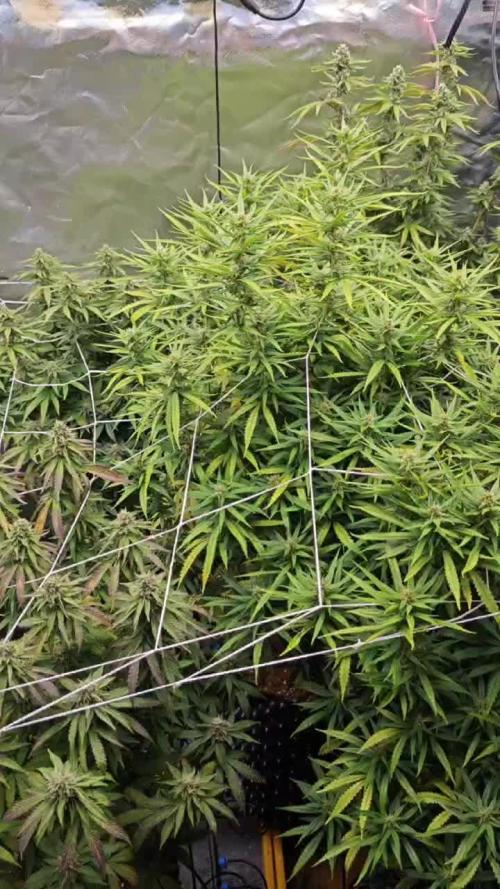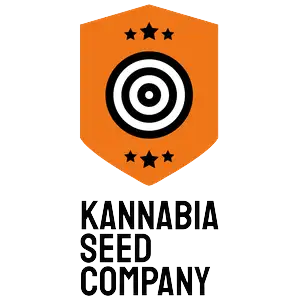By continuing to use the website or clicking Accept you consent to our cookies and personal data policy and confirm that you are at least 18 year old. For details please see Privacy Policy and Terms
Accept
Likes
Comments
Share


@weedelicious
Follow
Day 64:
I've been on vacation for four days now. However, I was able to keep an eye on everything remotely using the spiderfarmer app. They look great. The Pink Cookies and the Purple Kush have grown quite a bit taller. The buds have generally grown larger and the first frost is visible. I watered all the plants with 2 liters of water mixed with fertilizer and Cal Mag. More shoots have also woven into the web.
Day 65:
Not much has changed since yesterday. The plants look healthy and happy. I lowered the light by 10 cm. I hung the fan over the lamp and set it to a faster speed. The flowers look beautiful. Since the Pink Gelato is growing taller now, I had to adjust the humidifier a bit. What varieties are you currently growing?
Day 66:
The girls are doing well! Today I defoliated the plants again. I decided to remove some of the leaves so that the top buds would grow nicely and I'd have as few popcorn buds as possible. I hope it wasn't too much. I also watered all three plants with 2 liters of water mixed with Hesi-Bio-Bloom and Cal Mag. Unfortunately, it's still quite warm in the tent. Do you have any ideas how I can get the temperature down?
Day 67:
Everything's still going well. They've taken the defoliation well so far and look healthy.
Day 68:
Today I gave them another 2 liters of water with fertilizer and cal mag. They look beautiful and have another 5-6 weeks to develop the flowers!
Day 69:
Today, all three girls received 2 liters of water with fertilizer and Cal Mag. I also raised the Purple Kush and created a raised area underneath it. I also increased the humidity to counteract the heat.
Day 70:
Today, all three girls were given 2 liters of water with fertilizer and CalMag. Otherwise, not much has happened. The buds are getting bigger and bigger. Unfortunately, it's still too hot in the tent—I hope it cools down soon!
Likes
Comments
Share


@Danger_Mouse
Follow
There are two clearly differentiated phenotypes, but they are all beautiful plants.
Likes
18
Share


@SpotWeed420Original
Follow
En este proceso de germinación fue completamente exitoso ... Logrando agregar las semillas dentro de un baso con agua durante 12 horas pasando las a una servilleta durante 24h y logrando obtener la raíz ya el día de mañana pasarán a su maceta definitiva.
Likes
14
Share


@Mrs_Larimar
Follow
2024-08-31
One more Week and she will be harvested too, this is around her 5th. week in Flower,
and she buddes up very well, as long as it stays hot and dry she can stand, but if it starts to rain for days, iam going to cut her.
BREEDERS INFO
What exactly are the genetics in Auto Critical Orange Punch?
Auto Critical Orange Punch is a feminized autoflowering seed variety, the first Dutch Passion auto to use Critical genetics. The genetic base was Grandaddy Purple (Purps) x Orange Bud. This was called Orange Punch, and gave great potency and flavor. But yields were below average until she was crossed with an elite XXL Auto Kritical Bilbo. Auto Critical Orange Punch is one of our strongest strains with abundant yields and white buds that are completely covered with a thick layer of resin and beautiful orange flower hairs.
Auto Critical Orange Punch has thick compact buds that will provide a good yield in a relatively short period of time
Auto Critical Orange Punch is the autoflower seed version of our photoperiod Critical Orange Punch. This stable hybrid cannabis plant has roughly the same Indica and Sativa genetic content and can be regarded as a 50/50 variety. In this autoflower version, ruderalis genes (autoflower genetics) have of course also been crossed to make this strain flower automatically. This results in slightly more phenotype differences between the different plants than in the photoperiod version.
This strain can grow quite fast during the first 5-7 weeks of its life cycle. She grows strong branches that can bear long flowers. Blooms of 30-50 cm are no exception. She is classified as an XXL autoflower for all the right reasons! Her leaf structure is also that of a hybrid, she can grow very large fan leaves that convert a lot of light into energy. By the end of the flowering phase, the thickest branches with the heaviest flowers will need some support. By the 9th - 10th week, the buds will become so heavy that the branches can collapse under the weight.
Likes
64
Share


@Natrona
Follow
Sponsored grow 👉Weed Seed Express👈
Love Potion Auto Week 4 2/2-2-8
Love Potion Automatic is in still in veg. She was late to the party and now she’s just hanging around without flowers in her hair. Delay in flowering due to topping week 3 of veg.
She is growing about 1.5 inches a week. Slow compared to the other gals already in flower.
At the beginning of the week, she was 6 inches tall, Wed 7.5 and today 2/7 she is 9 inches tall.
I’ve moved the pins out to the edge of the pot. For future training, I must add some wires through the pot holes to keep the branches lower. I’ve spread the top out and a few limbs are taller than the others.
I reduced nutrients in the feed solution since Runtz and Pink Rozay are showing some purples/blues in the leaves. I added Green Sensation this week then read the instructions said add in 4th week flower. Love Potion Auto is an auto to be an 11 week flower from seed to harvest. If I wait till the 4th week, it will only be used for 2 maybe 3 weeks. Would that benefit the plant? So I think I will add some each time but a 25% strength. Calls for 4ml/g I will use 1ml. They are autos and I should be lowering the nutes anyway. Pinned more branches and lightly defoliatied. I add 2 gallons of water to the T700 humidifier daily to keep the VPD in line.
2/5 4 gal prep, each nutrient added at ½ of recommended amount. Making 4 gallons since I have 2 pots of carrots and Dill in the back. Fed 2 ltr each
Bloom Juice 60ml
Plant Juice 60 ml
Royal Rush 15 ml
power bud 15ml
green sensation 7.5ml
Recharge 2.5ml/gal
7.5 ml
Ppm 333
Ph 7.02
Temp 66
2/7 3 ltr each
Bloom Juice 60ml
Plant Juice 60 ml
Royal Rush 15 ml
Power bud 15ml
Green sensation not added
Ppm 298
Ph 6.5
Temp 65
Your likes and comments are appreciated. Thanks for stopping by.
Growers love 💚🌿
💫Natrona💫
Likes
6
Share


@Suchy329
Follow
Weiß nicht was ich schreiben soll. Die Pflanze kommt Halt gut 😁 und gab keine Probleme
Likes
7
Share


@Cannasino9
Follow
Look good!!! She's grown quite a bit this week. Now I'm watering it one day yes and one day no. She's appreciate that. This variety won't say no to food ( at least for the moment that's the feeling I get.) See you in the next week!
Likes
26
Share


@FUH20
Follow
2021 - 08 - 29
Wedding Glue Auto 1
- most fan leaf are starting to turn yellow , Hoping she finished up in a week to 2.
- Day 55 since sprout
- trichomes are mostly milky, not much amber on buds yet.
Wedding Glue Auto 2
- Some of the buds and fan leaf with abit of sugar leaf are turning purple...
- Day 50 since sprout
- She's fattening up nicely
image format : Wedding Glue Auto 1-4.1 day 27
Wedding Glue Auto 1( plant strain and tag number) , 4 (week), 1 (image number) , day 27 ( Date since sprout )
Likes
8
Share


@OS_Farmz
Follow
Look at those freaking towers on the right side;) and on these concrete jungle in the middle! Very satisfied with the ongoing process.
Likes
66
Share


@DrGreenThumb95
Follow
So... still rate of growth is not up to scratch and I dont know what is going on never the less they look nice and healthy, done a little bit of training this week but I just feel like I'm at a loss with the growth rate if any body has and pointers I'm all ears!?
Thanks for reading and happy growing!
Processing
Likes
15
Share


@Luv2Grow
Follow
Day 78 - She’s still got a little weight to her do not quite ready for some water. She’s definitely showing some deficiencies in her leaves right now but she’s coming down to the end so just gonna continue with what I’m doing until chopping. I might actually do a good flush tomorrow and give her nothing but water till the end.
Day 79 - Gave her a flush today with 2 gallons of water and Foxfarm’s Sledgehammer. Now it’s just a waiting game for her to finish up. She’s showing some amber trichs so it’s looking like she’ll be getting the chop this coming weekend.
Day 80 - She’s definitely started to fade quite a bit now and there is a ton of amber trichs. I’d like her to make it to the weekend but I’ll chop her sooner if need be. I think she’ll be ok and make it though.
Day 81 - More and more ambers showing everyday and I’m hoping she’ll make it till the weekend to get chopped. If I gotta chop sooner, I will. Her buds are nice and fat so looking like this is going to be an awesome harvest.
Day 82 - Nothing new, just waiting until the weekend to chop. Possibly Friday after work!
Likes
7
Share


@Adkguerrilla44
Follow
Wow...I wish I had of started 10 of these instead of 3,the one I didn't transplant is in full bloom and looking amazing, they look more like plants grown indoors more than outdoor grown. Candy kush express #2 is doing great but I'm wishing I had of put her in a 15 gallon bag rather than a cut up 10ish gallon bag but she's still doing wonderful. Candy kush express #3 is getting massive and almost looks like my other plants that are 1 or 2 months older!! I really pray that this bud is fire🔥🔥🔥🔥🔥🙏 🙏 🙏 feeding candy kush #1 raw,candy kush #2 is getting top feedings and foop organics and candy kush #3 is getting lotus
Likes
19
Share


@Lickey
Follow
Easy grow. Sold no fuss strain. Big buds.
This is probably my favourite strain for consumption. Very head high but powerful. One of the few strains that has absolutely 0 after effects. No hangover. No stupids. The larff and shake made excellent coconut oil for Nanaimo bars.
Likes
2
Share


@Ninjabuds
Follow
The strawberry gorilla has come out of the soil and it pushed itself up very well without having to dig it up out the soil. This is one plant I’m excited for I hope it grows to look like the photos
The temps are rising around here making it some much easier to start seedling than in the winter with heater on full blast
Likes
71
Share


@MarcXL
Follow
At harvest day I just cut off the stem and let them dry hanging over as complete plant and will trim them afterwards. Smell is killing me, whole house is smelling like haze. Had a lot of work to separate the roots off the soil.
























